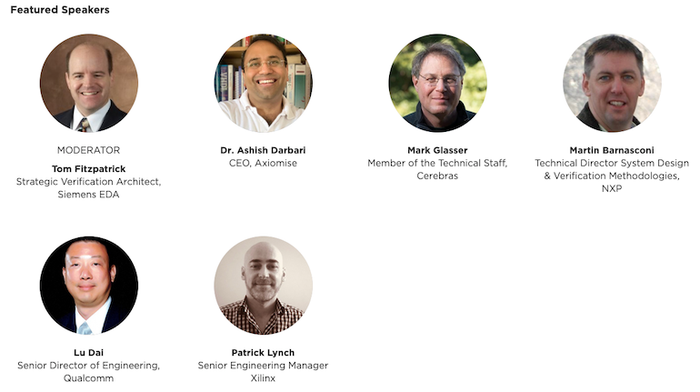Working from home was especially difficult for younger chip verification engineers. Read why.
June 23, 2021

The pandemic accelerated the sharp rise in professionals working from home. Some people did well while others struggled. This dynamic was particularly acute in the semiconductor industry, which has experienced unique challenges as engineers attempt complex chip innovation from their home offices.
A recent verification expert panel was convened by the Accellera and SEMI/ESD Alliance to acknowledge these challenges and compare experiences. The panel outlined several Best Practices for chip design and verification engineers as they continue working from home, as well as the reality of eventually getting back to the office.
The panel was moderated by Tom Fitzpatrick from Siemens EDA. He explored the range of challenges and triumphs with a discussion of verification engineers from various semiconductor disciplines and company sizes. Panelists included:
Martin Barnasconi, Technical Director System Design & Verification Methodologies, NXP
Lu Dai, Senior Director of Engineering, Qualcomm
Dr. Ashish Darbari, CEO, Axiomise
Mark Glasser, Member of the Technical Staff, Cerebras
Patrick Lynch, Senior Engineering Manager, Xilinx
Fitzpatrick: What are some of the biggest challenges you and your teams face when working from home?
Lynch: The main challenge that I’ve seen over the last year has to do with time management. I find my days are now full of Zoom video calls, which makes it very challenging to fit your normal day-to-day activities into reasonable hours.
Glasser: I find it challenging to maintain contact with all the people I need to interact with, especially without the informal hallway meetings we used to have.
Dai: I think the biggest challenge during the work from home lockdown was the meaningful meeting deficiency. I’ve experienced an increase in unproductive meetings and meetings that seem never to end. They go on for longer than is necessary and occur at all times of the day. It appears that meeting organizers assume that everyone can attend any meeting at any time.
Darbari: I suppose the most significant challenge is the lack of social interaction. Before the pandemic, I would go to customer sites to see people in person. But when you’re virtually connected and if a person chooses not to turn on the camera, then you lose the visual side of communication and the little visual clues gained from physical meetings.
Fitzpatrick: How quickly were your teams able to adjust to working remotely?
Dai: We handle most of the technical work without a problem. One challenge is using a whiteboard during a brainstorming session. It’s not as easy to do remotely. The other team challenge was faced by new junior hires, typically just out of school. They had never seen or met anybody from the company in person and worked that way for over a year.
Lynch: Just after being sent home, we realized that we needed to access the labs to test our chips. This required us to change the entire verification lab set up so that all the equipment in the lab could be remotely controlled. Thus, we had to install cameras in the lab to monitor everything during a test. Once the initial setup was complete, all that was required from time to time was for somebody to physically change a chip on a board or set up a board initially. But after that, it was pretty much completely remote. This proved to be of great benefit, to be able to run the testing remotely, go through all the power cycles and similar processes.
Fitzpatrick: What have been the downsides to WFH?
Darbari: Not being able to switch off the computer at home is the most potential downside.
Lynch: Even if you could switch off, there wasn’t much else to do as the pandemic shut down everything. Still, the fact that people could not or would not take vacation time has positively impacted the schedule and added to the already high productivity gains from working at home.
Dai: That is why it was essential to find ways to maintain some human interaction. We emphasized a lot more one-on-one meetings with the video channel, where you can see each other’s faces. There was also a lot more checking up on people to see how they are doing. It’s a little bit different than your traditional manager-employee one-on-one, in which you’d focus only on project progress and career development rather than personal activities. The junior engineers especially needed human interactions.
Fitzpatrick: What helped to overcome these downsides?
Dai: Junior engineers seemed to suffer the most stress during the lockdown. Literally, they would wake up in the morning, work through the day and then go to sleep. Plus, many lived in an apartment where they worked in the same room to sleep. Some didn’t even have a desk on which to work, so they worked from the bed. We encouraged them to create an ergonomic arrangement and set up their workspace in the living room, not the bedroom.
Darbari: I found it helped to ask your interns and junior engineers simple questions, perhaps during code compilation. What did you have for dinner? How is your family? Such questions helped create a more human conversation.
Martin: It helped to have the video on to see one another and see if they seemed to follow the discussion and what is going on.
Mark: I had to train young engineers to get up to speed on design and verification tasks. One thing I did was to conduct weekly one-hour sessions where I would assign some problems. They would go away and work on these problems by collaborating with each other on the problems. This provided an opportunity for them to get to know each other and bond a little bit without the stress of the real work that they were doing
Fitzpatrick: Working remotely may now be a preference for many employees. Should they be forced to return to the office? What should we do as the pandemic eases?
Glasser: In my personal opinion, as long as you’re getting your work done, it doesn’t matter where you do it. You should do it at the point where it’s most comfortable because your good thoughts, your clever thinking, don’t always occur during typical work hours.
Darbari: It’s good to be able to meet a few times in the year. But working remotely will save a lot of waste time and money associated with relocating people. Plus, relocating can be very disruptive to employees and companies.
Dai: I would say that working remotely is a massive opportunity for the company. Companies can say capital costs by not having to maintain all of those office buildings and such. Plus, companies can hire the best employees from around the world. Some companies worry about productivity that their employees might go to the beach or watch a movie during the day. But really, why should they care if an engineer takes off for a few hours during the day but then works, later on, to meet all their deadlines successfully? He or she got their work done, and it’s still of good quality. Companies that offer remote work with occasional visits to the office will stand out and be places where talented people will want to work.

John Blyler is a Design News senior editor, covering the electronics and advanced manufacturing spaces. With a BS in Engineering Physics and an MS in Electrical Engineering, he has years of hardware-software-network systems experience as an editor and engineer within the advanced manufacturing, IoT and semiconductor industries. John has co-authored books related to system engineering and electronics for IEEE, Wiley, and Elsevier.
RELATED LINKS
About the Author(s)
You May Also Like





